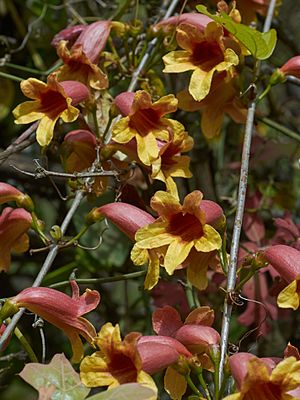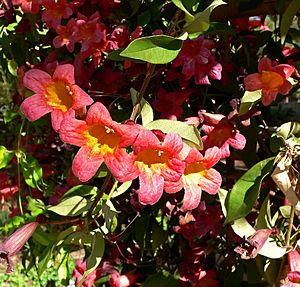Bignonia capreolata facts for kids
Quick facts for kids Bignonia capreolata |
|
|---|---|
 |
|
| Scientific classification | |
| Genus: |
Bignonia
|
| Species: |
capreolata
|
| Synonyms | |
|
|
Bignonia capreolata, commonly known as crossvine, is a type of vine. It gets its name because if you cut its stem, you'll see a cross-shaped pattern inside. This pattern comes from special plant tissues called phloem (which carries sugars) and xylem (which carries water). Crossvine grows naturally in the central and southern parts of the United States.
This vine climbs without wrapping itself around things. Instead, it uses small gripping parts called tendrils to hold on. Crossvine produces long, tube-shaped flowers that are usually red and yellow. These flowers often have a pleasant smell, sometimes like mocha. Its leaves are dark green, sometimes even a bit purple. They grow in pairs, with tendrils at the end of each pair. The vine can climb very high, and often, you'll only see leaves near the top. Crossvine can spread quickly through underground stems called stolons, so gardeners might need to manage its growth.
Contents
What is Crossvine?
Crossvine is a strong climbing plant. It is known for its unique stem pattern. This plant adds beauty to many natural areas. It also has an interesting history of use.
How Crossvine Grows
Crossvine uses special tendrils to climb. These are like tiny arms that grab onto surfaces. It does not twist around objects like some other vines. This plant can reach impressive heights. Its leaves often stay on the highest parts of the vine.
Crossvine's Flowers and Leaves
The flowers of the crossvine are quite striking. They are long and shaped like trumpets. Their colors are a mix of bright red and yellow. Many people enjoy their sweet, mocha-like scent. The leaves are dark green and grow in opposite pairs. This means two leaves grow from the same spot on the stem, facing each other.
Traditional Uses of Crossvine
Long ago, Native American groups used plants for many purposes. The Cherokee people, for example, used crossvine. An old report from the 1700s describes this use.
They would cut the vine into pieces. Then they would boil it with other plants. These included china brier and sassafras roots. They drank this mixture as a "diet drink" in the spring. People believed it helped to make their blood and body fluids healthier. It was also an important part of a special drink. This drink was used to help with various ailments.
In 2012, scientists at Bastyr University studied crossvine. They found a special chemical in it. This chemical is called reserpine. This discovery shows that crossvine contains interesting natural compounds.


